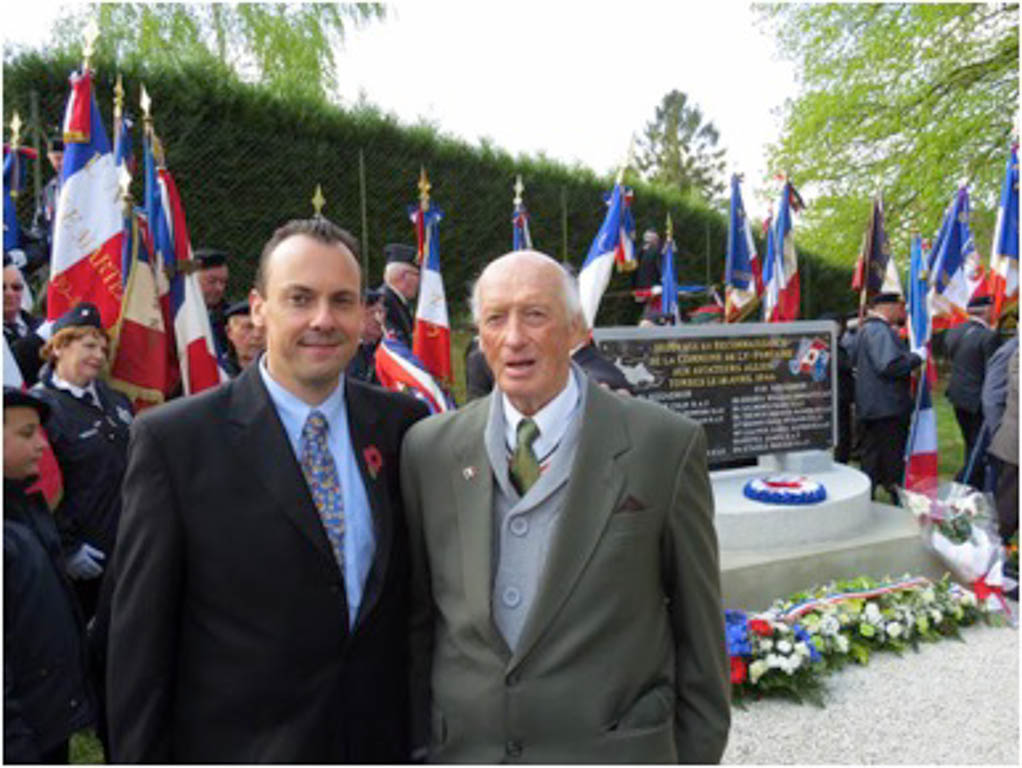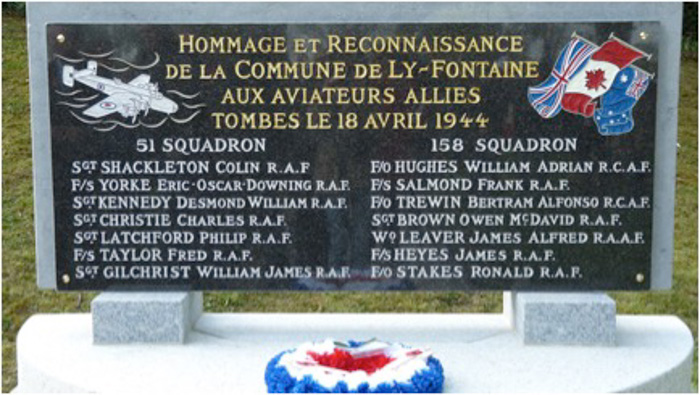On the evening of April 18, 1944, a Halifax bomber, Serial No. LV946, coded “NP-K”, of 158 Squadron took off from RAF Lissett in East Yorkshire at 20:59, detailed to attack the railway yards at Tergnier, France. It carried the usual crew of seven with F/O William Hughes, RCAF, as Pilot. This was the 10th operation for this young multi-national crew. Halifax LV946 was one of 21 bombers from 158 Squadron involved in the operation that night. The attack appeared successful, but the German night-fighters had anticipated the route the bombers had taken and attacked the bomber stream relentlessly on their return. In the ensuing action and as the bombers took evasive action while the German night-fighters attacked, Halifax LV946 collided with Halifax bomber LW522 of No. 51 Squadron. Both aircraft crashed to the ground at 23:34 near the French village of Ly-Fontaine killing both crews.
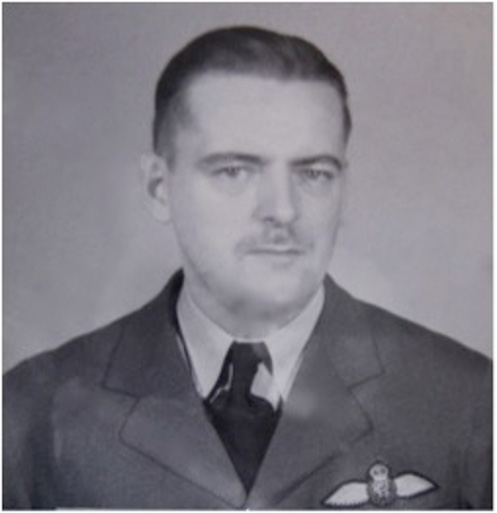
William Hughes was born in 1912, at Vonda, SK, Canada. His father had emigrated to Canada from the UK and his mother had emigrated from the Netherlands. He initially enlisted in the RCAF in January 1940, in Ground Crew, but remustered to Air Crew in 1941. He was trained in Canada as a Pilot and was sent overseas in May 1943. He was posted to No. 23 OTU at Pershore where he selected his new crew. He was posted to No 1663 HCU at Rufforth for conversion training to fly the Halifax bomber in November 1943. Upon completion he was posted to 158 Squadron on February 28, 1944. At the time of his death he was 31 years old. He was married to Annetta Hughes.
Frank Salmond was from Craigiebank, Dundee, Scotland. He initially joined the Army but transferred to the to the RAF. He was posted to No. 23 OTU at Pershore where he crewed up with F/O Hughes as pilot and the rest of his crew. He was posted to No. 1663 HCU at Rufforth for conversion training to fly the Halifax bomber in November 1943. Upon completion he was posted to 158 Squadron on February 28, 1944. At the time of his death he was 28 years old.
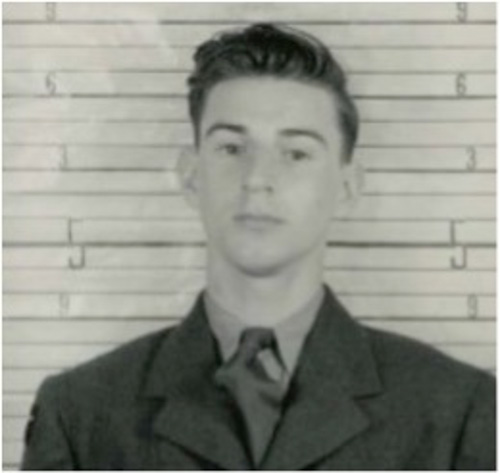
Bertram Trewin was from Halifax NS, Canada. He enlisted in August 1942 and was trained initially in Canada. He was posted overseas in June 1943. He was initially posted to No. 25 OTU at Finningley and then to No. 1663 HCU at Rufforth for conversion training to fly the Halifax bomber in November 1943. It is at No. 1663 Unit where he crewed up with F/O Hughes and his crew. At the time of his death he was 22 years old.
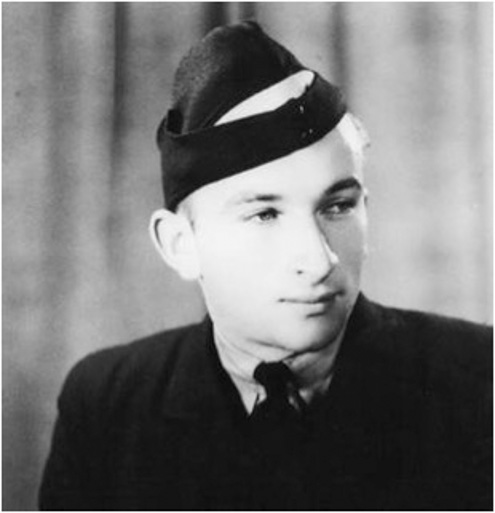
James Leaver was from Yenda, NSW, Australia. He enlisted at Bradfield Park on July 19, 1941. His initial training was in Australia but was later sent to Canada under the BCATP, for Wireless, Gunnery and Observer/Navigation training. He arrived in the UK from Canada in May 1943 and was posted to No. 23 OTU at Pershore where he became part of F/O W. A. Hughes crew. He was posted to No. 1663 HCU at Rufforth for conversion training to fly the Halifax bomber in November and upon completion he was posted to 158 Squadron on February 28, 1944. At the time of his death he was 22 years old.
James Heyes was initially posted to No. 28 OTU at Wymeswold and then to No. 1663 HCU at Rufforth for conversion training to fly the Halifax bomber in November 1943. It is at No. 1663 Unit where he crewed up with F/O Hughes and his crew. Upon completion of this final phase of his training, he was posted to 158 Squadron on February 28, 1944.
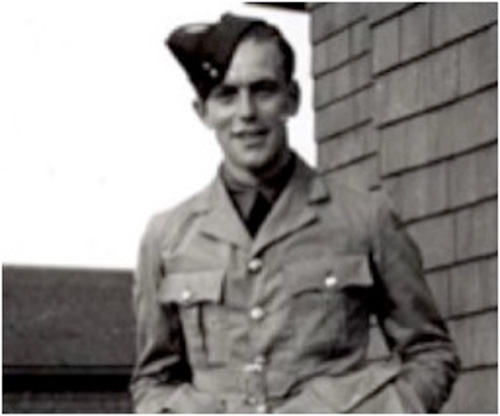
Ronald Stakes was from Wakefield, Yorkshire. He enlisted at Padgate and was trained in Canada under the BCATP. He was posted to No. 25 OTU at Finningley and later posted to No. 1663 HCU at Rufforth for conversion training to fly the Halifax bomber in November 1943. Upon completion he was posted to 158 Squadron on February 28, 1944. At the time of his death he was 23 years old. He was married to Rose Edith.
Owen Brown was from Dumfries, Scotland. He enlisted at Edinburgh and was trained at No. 4 School of Technical Training at St. Athan. He was posted to No. 1663 HCU at Rufforth where he joined F/O Hughes’ crew. Upon completion he was posted to 158 Squadron on February 28, 1944. At the time of his death he was 19 years old.

During a bombing mission many of the bombers were forced to take evasive action when a night fighter picked them as a target and this often led the pilot to throw the aircraft into a corkscrew dive. In the mayhem that followed that night as the bombers headed back to base and were attacked by German night fighters, two bombers, one from 158 Squadron and one from 51 Squadron, collided. Pierre Laurence, a young local resident, heard the planes overhead as he was rushing his wife and baby into a bunker. He also heard the terrible crash and saw the debris come raining down. Laurence later assisted the German authorities in collecting the remains of the airmen for burial. Both aircraft crashed to the ground at 23:34 near the village of Ly-Fontaine, approximately 130 km NNE of Paris, killing all 14 crew members. The airmen were buried in the Seraucourt le Grand British Cemetery. The cemetery is 8 kilometres SW of St. Quentin on the east side of the River Somme. It contains the graves of over 2000 soldiers who died in WWI, as well as a few allied airmen who died in aircraft crashes near this location in WWII.
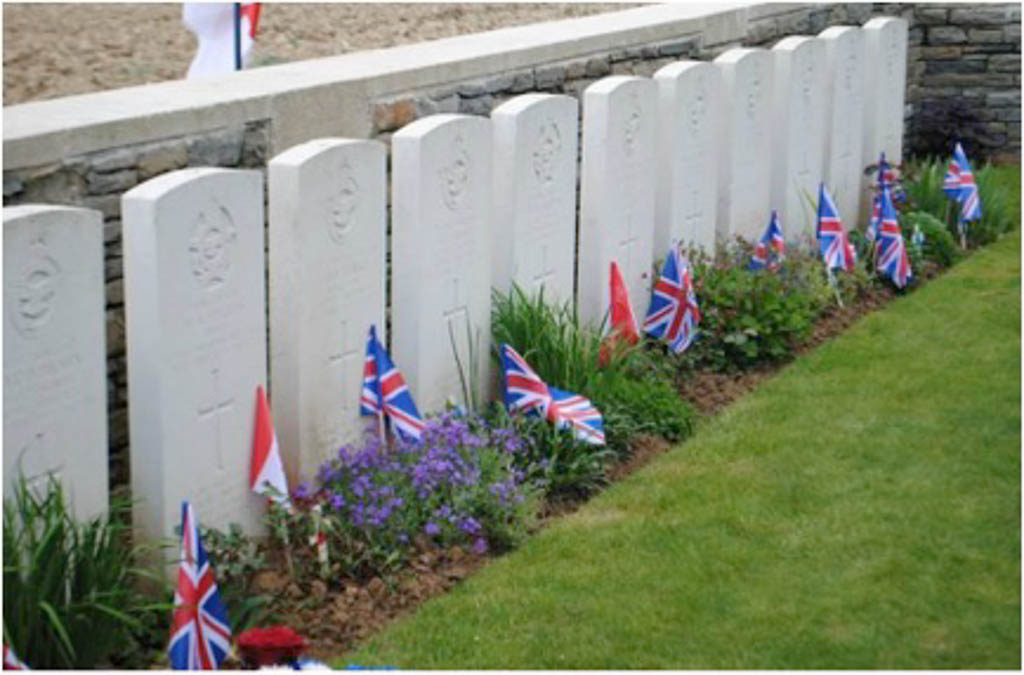
On April 19, 2014, a very special ceremony was held in Ly-Fontaine, France to commemorate the 70th anniversary of the loss of the fourteen young airmen who were killed when their Halifax Bombers were involved in a mid-air collision and crashed near the village in 1944. Through the untiring efforts of Pierre Laurence, the last surviving witness of the crash and a young researcher Philippe Lantiez and the good citizens of Ly-Fontaine, a remarkable marble memorial was erected at the site of the crash, in remembrance of the two crews. Family members came to Ly-Fontaine to participate in the unveiling ceremony including the sister and niece of W/O Leaver who traveled from Australia to attend.
